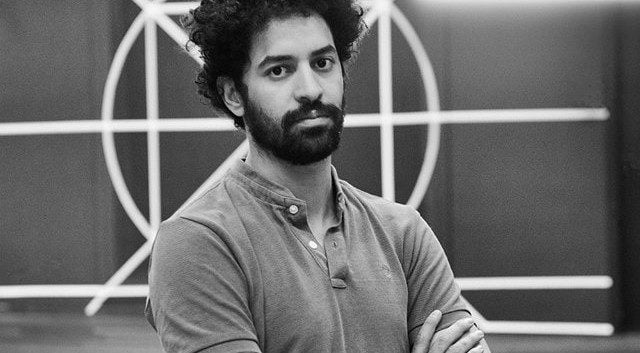
- News
Creating Space and Dismantling Hierarchy: Radouan Mriziga’s 7
Radouan Mriziga’s 7 is the final installment in a trilogy exploring the relationship between the human body and the spaces it constructs and occupies. Read here the whole interview with Radouan Mriziga, conducted by Morgan Amonett.
By Morgan Amonett, for the Wexner Center for the Arts (Columbus – USA), November 4 2019
Radouan Mriziga’s 7 is the final installment in a trilogy exploring the relationship between the human body and the spaces it constructs and occupies. I was fortunate to speak remotely with Mriziga about his background, the concepts behind the trilogy, and plans for the future.
Growing up in Marrakesh, Mriziga was exposed to some of the most stunning physical spaces humans have created. A traditional art education, centered around institutional instruction, was not available. Instead, the manifestations of ancient geometry and magnificent architecture, alongside street art, and hip-hop culture informed his artistic tastes, as did sports, and his inclinations toward mathematics. When he finally studied dance, the inspiration of these rich, organic, and collectively available sources of information continued to impact his work.
Mriziga frequently referred to the hierarchy of relationships between the intellect, the body, and the spirit. The “western” inclination is, and has been for many centuries, to prize the intellect over the body and the spirit. In contrast, he emphasizes the fallibility of this concept, arguing that intellect and body exist horizontally: that is, (mostly) level with one another. For him, these elements are not one and the same; within an artistic and abstract context, he allows for variation and emphasizes emotional reactions to and intuitive participation with his work; and, by extension, to other works of art.
Acting in toxic accordance with this concept, he says, is another hierarchy: that which places more value on certain methods of communicating and storing knowledge than others. Predictably, the most highly valued methods are the “western” ones; anything written or empirical, under this system of classification, is deemed inherently more valid than information communicated in other ways. This scale of assigned acceptability marginalizes cultures and people who store, communicate, and discuss knowledge in other ways. In limiting the spread and consumption of information in this way, he notes, we confine ourselves to certain methods and dimensions of expression and lose out on a great deal of learning.
The Trilogy: 55/3600/7
In these three pieces, Mriziga confronts these concepts among others, challenging audiences to reconsider the mind/body/spirit hierarchy and work to accept new ways in which we can communicate and apply knowledge. In 55, the first installment in the trilogy, he constructs a two-dimensional space using chalk and tape; the measurements for this space are both defined and given by the body and its movement. In this work, he both defines the physical with respect to what it can create and defines the creation in terms of the physical; the body constructs the space, so the space is constructed for that body. In 3600, he broadens both the conceptual and physical scope of his work; the construction in this piece yields a three-dimensional product.
7 is simultaneously the most complex and the most accessible. It adds both time and imagination to the other three dimensions, inviting and requiring the audience’s direct engagement. Mriziga noted that the space constructed in 7 will be shaped by the space already occupied by the audience. Influenced by the seven wonders of the ancient world, he says that participants in the piece will hold those monuments in their imaginations while not actually seeing them represented on stage. In this way, the space created is one that will take shape collectively.
Plans for the Future
In his new project, he plans to challenge the creation of the “western” canon by exploring the “epistemologies and mythologies of the Tamazigh, the indigenous population of Northern Africa.” Though their culture influenced other, more recognized societies in the ancient Mediterranean significantly, these people have been largely ignored by scholars of the region. He explores and criticizes the reasons for this neglect in his new work, again challenging the construct of knowledge in “the west” and presenting a more thorough history of a complex and influential culture with a different way of communicating information.
Radouan Mriziga (1985) is a choreographer and dancer from Morocco, currently living and working in Brussels. After studying dance in Morocco, Tunisia and France, Radouan Mriziga graduated from PARTS in Brussels. Fairly quickly he began to focus on his own work, creating his first solo, 55, followed by the group piece 3600 in 2016, and in 2017 another group piece called 7. His works have been touring in major festivals and theatres worldwide. His performances explore the relationship between movement, construction and composition. Focusing on human beings as the makers of their surroundings, Mriziga’s choreographies forge links between the body in motion and the expression of form in everyday materials and the architecture of our built environment. Mriziga is an artist-in-residence at Moussem Nomadic Arts Centre, and between 2017-2021 at the Kaaitheater (Brussels).
7 is shown during SPRING in Autumn 2021, on 30 and 31 October at Werkspoorfabriek. You can buy tickets here.
Picture: Bea Borgers